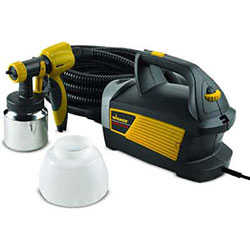The Best Latex Paint Sprayer — Buyer’s Guide, How-To, Reviews, and Comparisons
A stellar latex paint sprayer will help you add a splash of color to a whole multitude of surfaces. An appropriately sized nozzle will atomize the paint perfectly, as well as offer even coverage. It should also be effortless to maneuver from your workshop to your project setting.
- 25-foot flexible hose.
- 0.63-quart paint container.
- 1.3-mm fluid tip.
- Includes a handy viscosity cup.
Latex Paint Sprayer Comparison Table
| IMAGE | PRODUCT | DETAILS | ||
|---|---|---|---|---|
|
Best HVLP Latex Sprayer 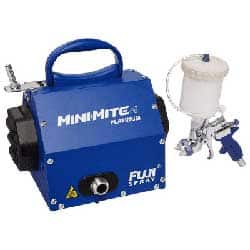
|
Best HVLP Latex Sprayer
|
Features
|
Check Price at Amazon Fuji 2804 T75G Review Fuji 2804 T75G Review | |
|
Best Paint Sprayer for Unthinned Latex Paint 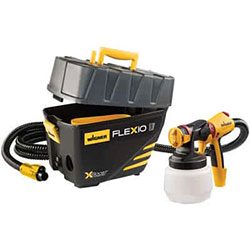
|
Best Paint Sprayer for Unthinned Latex Paint
|
Features
|
Check Price at Amazon Wagner Flexio 5000 Review Wagner Flexio 5000 Review | |
|
Best Airless Paint Sprayer for Latex Paint 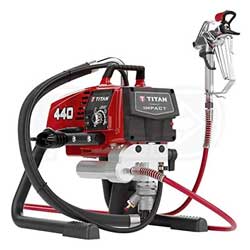
|
Best Airless Paint Sprayer for Latex Paint
|
Features
|
Check Price at Amazon Titan 440 Review Titan 440 Review | |
|
Best for Large-Scale Projects 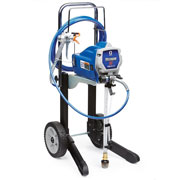
|
Best for Large-Scale Projects
|
Features
|
Check Price at Amazon Graco Magnum x7 Review Graco Magnum x7 Review | |
|
Best for the Money 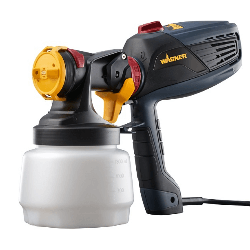
|
Best for the Money
|
Features
|
Check Price at Amazon Wagner Flexio 2000 Review Wagner Flexio 2000 Review | |
|
Best Air Compressor Powered Latex Paint Sprayer
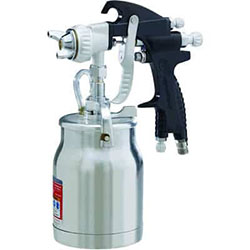
|
Best Air Compressor Powered Latex Paint Sprayer
|
Features
|
Check Price at Amazon Ingersoll Rand 210CSA Review Ingersoll Rand 210CSA Review | |
|
Best for Weekend Warriors 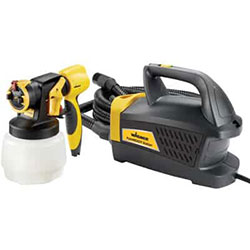
|
Best for Weekend Warriors
|
Features
|
Check Price at Amazon Wagner PaintReady Review Wagner PaintReady Review | |
|
Best LVLP Spray Gun for Latex Paint 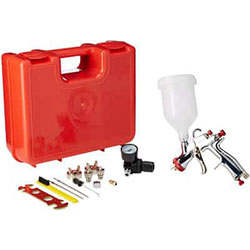
|
Best LVLP Spray Gun for Latex Paint
|
Features
|
Check Price at Amazon Sprayit SP-33000K Review Sprayit SP-33000K Review | |
|
Best Prosumer Latex Sprayer 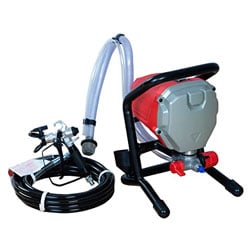
|
Best Prosumer Latex Sprayer
|
Features
|
Check Price at Amazon Himalaya Airless Review Himalaya Airless Review |
Latex Paint Sprayer Buying Guide
- A correctly sized nozzle.
- Adjustable settings.
- An uptake hose or generous paint cup.
- Portability.
What Is Latex Paint Used For?
This is all very well but what surfaces can you apply it on, you may ask. As it’s available in a variety of finishes, from gloss to flat, it is typically used on walls and ceilings. But it can also be used to revamp wooden furniture, so long as a primer is used first on bare wood.
There is also the option of exterior latex paint, which is formulated for use outdoors. Slightly denser than its indoor equivalent, it provides resistance against the elements and protects against issues such as mildew.
How To Choose the Best Latex Paint Sprayer
To speed things up a bit for you, I have compiled a short blurb on later sprayers’ critical features and how they could benefit you.
Nozzle Sizing
The majority of sprayers designed for use with latex come with a 0.015-inch (or equivalent) nozzle and are therefore ready to use when they arrive. That said, if you need a larger tip, all is not lost since many machines are compatible with different sizes. Although they will usually need to be purchased separately.

Variable Settings
Variable settings also mean you can adjust the tool to your experience level. If you’re a pro you can ramp up the pace, and if you’re a newbie you can spray slowly and steadily.
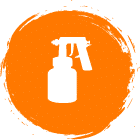
Uptake Hose or Paint Cup
A flexible uptake hose, on the other hand, eliminates paint cup refills altogether. Instead, the hose draws paint directly from the original paint can, and most are compatible with one or five-gallon tins. This could be overkill on smaller applications, but if you’re on a mission to update a large project, uptake hoses allow you to work without interruptions.

Portability
Of course, handheld units are also incredibly easy to move between jobs and when operating, your reach is only limited by the length of your extension cord.

Technology
HVLP, LVLP, or airless? It all sounds like some obscure alphabet that can’t possibly relate to painting latex. To simplify matters slightly, let’s have a quick look at what each type of spraying technology can offer in the latex world.
A high-volume, low-pressure (HVLP) unit is great if you are looking to reduce the dreaded overspray. It will allow you to put more paint on your actual project and less on the surrounding area — making this type of latex sprayer ideal for interior use.
Conversely, low-volume, low-pressure (LVLP) devices are great as they only need low pressure to deliver low-volume output. This means that you only need a small home compressor to power your sprayer. For a more thorough explanation take a look at my HVLP vs LVLP review.
Now for airless machines. Typically, these work well on medium to large jobs and operate at high pressure — meaning they get the job done quickly.
There is no hard and fast answer as to which is ‘best’ as each of these painting technologies has its merits.
How To Use a Latex Paint Sprayer
How To Spray Latex Paint on a Wall: A Step by Step Guide
What You Will Need to Follow This Tutorial
Gather everything you need before you start to maximize your uptime and make the task stress-free.
- Latex paint sprayer.
- Suitable nozzle for latex coatings.
- Latex paint.
- Drop cloths or plastic sheets.
- Masking tape.
- Damp cloth.
- Dish soap.
- Fan.
- Coveralls or old clothes and shoes.
- Eye protection, gloves, and face mask or respirator.
Step 1: Preparing Your Room
- Start by moving as much as you can from the room to give yourself enough space to work.
- Ventilate the room by opening a window if possible. If not, use a fan. Be careful not to create too much breeze that it interferes with your spraying, though.
- Place a drop cloth or plastic sheeting on the floor and cover any other items that you can’t move out of the way.
- Tape over any electrical outlets, lights, window, and door frames.
- Make sure that your wall is clean. The best way to do this is with a damp cloth. If you have any greasy handprints or the like from small children, add a little dish soap to the cloth and wipe away. Ensure that all soap residue is removed by another damp cloth before leaving to dry.
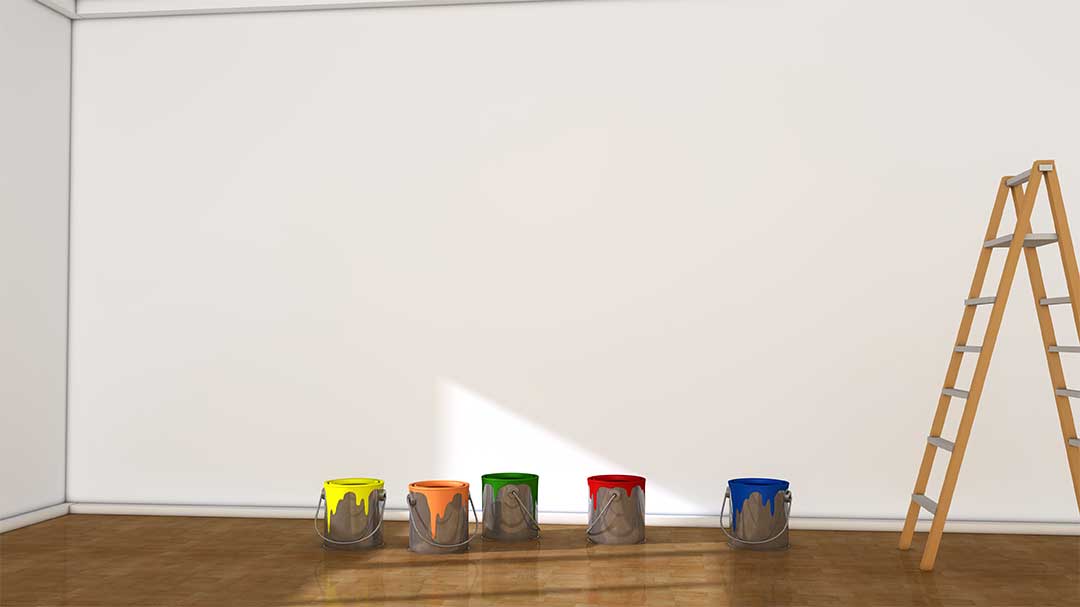
Step 2: Start Painting
- Don your protective equipment and set up your sprayer. Make sure that a suitably sized fluid nozzle is installed and adjust the device’s settings per the user manual. If you need to thin the latex before use, check out my handy guide below.
- Begin spraying, starting at the top and working your way down. Keep the sprayer around 12 to 15 inches away from the wall’s surface to maximize atomization and guarantee an even pattern.
- Cover each previous swipe of paint with another pass of at least 50 percent. This will ensure total coverage of the surface.
- Once you have coated the whole wall, allow it to dry. Check the paint producer’s guidelines for drying time and the recommended number of coats. For every subsequent coat, follow steps two and three as necessary.
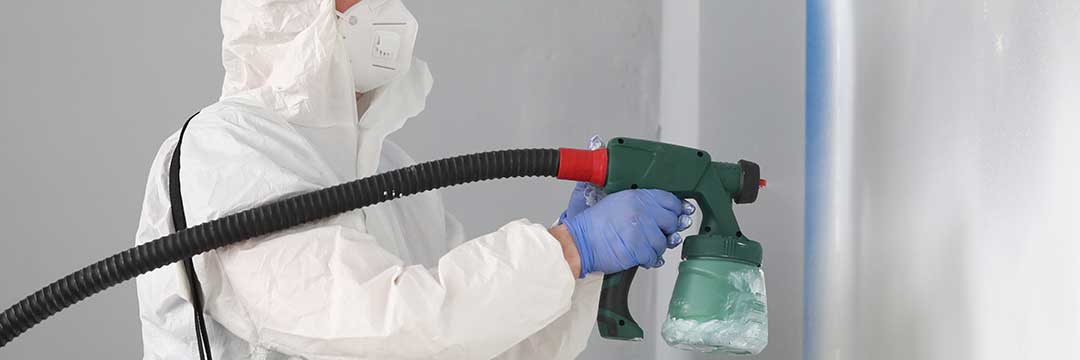
Step 3: Tidying Up
- When you have completed all coats, wash your paint sprayer. Take your time with this and make sure you reach all parts of the sprayer because if you miss any paint, it could damage your machine in the long run. Air-dry the unit before storing.
- Remove any tape and sheeting that you used for protection.
- Double-check that the walls are completely dry before moving items, such as furniture back into the room.

Thinning Latex Paint for a Paint Sprayer: A Step by Step Guide
What You Need To Know
Since latex is a water-based coating, it can be thinned using only water. Although there are some commercial latex thinners available, they can be pretty pricey, so water is usually the best option.
What You Will Need
- Latex paint.
- Water.
- Stir stick.
- Empty container.
- Measuring jug.

Quick Thinning Check
Before you start pouring water everywhere, it’s possible that your coating is already ready for use. In which case, it’s a good idea to conduct a test to determine if you even need to thin your paint.
The best way to complete this check is to simply insert a stirring stick into the paint can and then remove it. Allow the coating to set on the stirrer for a couple of minutes — ideally above the paint can to minimize the mess. If the coating still drips effortlessly off the stick after a few minutes, there is no need for thinning.
However, if it forms clumps or the majority of the paint remains on the stick, then it will need thinning before application.

How to Thin Four Quarts of Latex Paint
Start by adding half a cup of room temperature water to the empty container. Then add the four quarts of paint.
Mix together thoroughly using the stir stick. Aim for a spiral motion with a combination of up and down movements.
Complete a quick thinning check as described above. If your paint is thin enough and reminds you of the consistency of heavy cream, you’re good to go.
If it’s still clumpy or thick, continue to add more room temperature water at one ounce at a time. Stir thoroughly and be sure to check the consistency after each addition of water.
Nine Top Performing Latex Paint Sprayers
A heat dissipation chamber keeps this unit cool under pressure, while the four-stage turbine pushes out an operating pressure of up to nine psi.
The T-75G gravity-fed, non-bleed spray gun has stainless steel internals, which makes it easy to clean and adds corrosion protection. A 1.3-mm fluid nozzle and a nylon 0.63-quart (600 cc) coating cup work together to provide fine atomization and an ample paint supply.
Furthermore, the 25-foot Hi-Flex hose is a great length for most home-improvement tasks. Then there is a dual air filter that steps up to minimize clogs within the machine.
Fuji Spray is an award-winning Canadian company that specializes in HVLP spraying solutions for craftspeople, motorheads, and even tanning salons. This company has been in operation since 1986 and puts a substantial amount of effort into spraying equipment that’s easy to use.
- 25-foot hose.
- Two-year warranty.
- T-75G spray gun.
- 1.3-mm fluid nozzle.
- 0.63-quart paint cup.
- Heat dissipation system.
- Substantial price point.
- Design
- Functionality
- Price
Our Rating: 4.9
This Wagner spray gun for latex paint includes two nozzles to cover a range of various sized items — the iSpray for large surface areas and the Detail Finish tip for intricate work. Each has its own different capacity paint container to match its own uses.
The power controls are kept close to your fingertips with an integrated dial on the gun’s handle. Additionally, the variable speed settings permit coverage up to twelve times faster than a brush. When you’re done, everything stores neatly away in the onboard storage.
Wagner SprayTech created the FLEXiO series for DIYers and contractors who need high-quality, HVLP spraying technology. Based in Minneapolis, the Wagner name is associated with innovation and durability.
- Reduced overspray.
- Floor-based storage with integrated storage.
- iSpray and Detail Finish fluid nozzles.
- Two differently sized paint tubs.
- Variable power output.
- 11.5-foot hose.
- Can be prone to clogging.
- Design
- Functionality
- Price
It has the ability to spray between 50 and 100 gallons per month consistently, plus a full-size manifold filter that helps to keep clogs at bay. The RX-80 spray gun is fitted with a 517 nozzle, which is highly compatible with latex.
The manufacturer claims that the PermaLife cylinder will never need to be replaced as it never wears out. To make it easier to put your feet up at the end of a long day spraying, the Rapid Clean function speeds up cleaning.
US-based Titan Tools first hit the market in the 1970s. Titan prides itself not on creating gimmicks, but useful tools for DIYers and professionals in need.
- 517 fluid nozzle.
- 50-foot hose.
- Rapid Clean system.
- Quad Plus packings.
- Long-living cylinder.
- Filter removal can be messy.
- Design
- Functionality
- Price
Our Rating: 4.7
With a maximum flow rate of 0.31 gallons per minute (gpm) and a recommended usage of 125 gallons, this behemoth tool will make big tasks a pleasure to finish. The stainless steel piston pump provides substantial power, spraying even unthinned coatings with ease.
Furthermore, setting up the machine is both reliable and fast with the PushPrime feature, which, as the name suggests, allows priming at just the push of a button. Similarly, cleaning up is a hassle-free affair, as you can just attach the unit to your garden hose and rinse with the Power Flush system.
Graco Inc. is synonymous with high quality and durability, making them a favorite of many contractors and home improvers alike. With almost a century of experience backing its products, you can be sure that its tools are tried and tested to the max.
- 25-foot hose.
- 515 fluid nozzle.
- Wheeled cart design.
- Quick-start up guide and informative user manual.
- SG2 metal spray gun.
- 125 gallons recommended annual usage.
- No onboard storage.
- Design
- Functionality
- Price
The handheld configuration assures maximum portability and makes it easy to reach those awkward places you may encounter. And the two-speed X-Boost motor will cover big surfaces up to eight times faster than a traditional brush. When using latex, it should only take you six minutes to coat an eight by ten-foot surface.
Material flow can be controlled in 12 step increments, and with just a twist of the caps ears, you can switch between fan patterns. Maintaining this unit is simple; the Lock-N-Go system permits you to break the machine down into five separate parts for a thorough clean.
Wagner SprayTech developed the FLEXiO line as a series of HVLP tools angled toward weekend warriors and ardent DIYers. Wagner’s attractive yellow and black units have come to stand for quality sprayers that are simple to use.
- Two-speed turbine.
- iSpray fluid tip.
- 1.5-quart paint container.
- Handheld unit.
- Lock-N-Go system.
- No finishing nozzle included.
- Design
- Functionality
- Price
Our Rating 4.5
Refills are kept to a minimum on large tasks with a voluminous 1.03-quart paint container. And when you do need to top up the coating, a quick-release mechanism makes this a fuss-free procedure.
When you need to spray latex paint using this air compressor-driven gun, the 1.8-mm nozzle ensures that no thinning is required.
Weighing in at only 1.5 pounds with critical components manufactured from metal means this machine is not only lightweight, it’s also incredibly durable. The textured handle means that finger slippage is a thing of the past, so it feels balanced in the hand, too.
Ingersoll Rand originally started as two separate entities, Ingersoll-Sergeant and the Rand Drill companies. When these two pneumatic-focused businesses merged, they created the powerhouse that is Ingersoll Rand, now one of the premier producers of industrial-grade apparatus.
- Three fan patterns.
- Lightweight and ergonomic.
- 1.8-mm fluid nozzle.
- Variable material flow.
- 1.03-quart paint container.
- Cup quick-release connection can cause drips if the sprayer is inverted.
- Design
- Functionality
- Price
A powerful turbine pushes paint through the lengthy 15-foot hose, ensuring no loss of pressure. The iSpray nozzle applies a light, textured spray that is comparable to a finish achieved with a roller.
Paint flow is straightforward to adjust, meaning that it’s effortless to match the machine to your project’s needs.
Additionally, as the bulk of the device is contained in a floor-based housing, spraying fatigue is greatly minimized. The Lock-N-Go system permits quick changes of coatings, as well as stress-free cleaning.
Wagner SprayTech has been in operation for over seven decades and is a trendsetter in the fluid handling industry. In recent years, this company has gone from strength to strength, buying out other competitors such as HomeRight, Titan Tools, and Earlex.
- Seven times faster than a brush.
- iSpray nozzle.
- Adjustable pattern width.
- 15-foot hose.
- Floor-based turbine.
- Can be noisy on maximum settings.
- Design
- Functionality
- Price
Our Rating 4.4
The 20-ounce plastic paint cup compliments the one-piece aluminum spray gun, keeping it lightweight and arm and hand fatigue to a minimum. Additionally, air output and fan patterns can be controlled by just the twist of a dial.
Spraying latex paint with this gravity feed gun maximizes uptime as it includes everything you need to operate including a cleaning kit, air regulator, and a plastic carry case. This complete package means you can complete a variety of applications in a controlled, professional manner.
Sprayit boasts decades of experience and has operated since 1928. Over the years, it has developed a reputation as a trusted spray gun supplier. Customer praise Sprayit guns for their durability and quality.
- 20-ounce paint container.
- Three different-sized fluid nozzles.
- Includes air regulator, cleaning brushes, and carry case.
- Only requires a small compressor.
- Adjustable fan pattern, air, and paint output.
- The plastic paint cup is not as durable as metal equivalents.
- Design
- Functionality
- Price
A flexible suction tube negates the need for a paint container, allowing you to work straight from the original paint canister and eliminating refills. The compact design includes an ergonomic carry handle that makes for straightforward movement between jobs.
The spray rate is impressive at 0.28 gallons per minute and the manufacturer claims that 55 percent less overspray is delivered when compared to handheld equivalents.
The Himalaya airless sprayer is the only spray gun in Himalaya Hardware’s product line. The respected Red Thunder Inc., which also produces Thunder Hardware, manufactures this unit.
- Flexible uptake tube.
- Ergonomic stand with carrying handle.
- Operating pressure of 3000 psi.
- Spray rate of 0.28 gallons per minute.
- 25-foot hose.
- Relatively unknown manufacturer.
- Design
- Functionality
- Price
Conclusion
Let’s have a quick run-through of key features you want in a latex paint sprayer before you leave.
Make sure that the nozzle included on arrival is the best size for your coating — be it an interior latex or the slightly thicker, exterior version. You also require a portable tool, so that it’s effortless to maneuver between tasks.
Adjustability is another important aspect, especially when it comes to paint output and fan pattern. It will permit you to speed up spraying on larger projects and slow it down for smaller tasks.
All in all, a latex paint sprayer makes tedious brushes and rollers a thing of the past, offering a far better solution for updating your home.
Still have questions about spraying with a latex sprayer, check out the FAQs below!
Latex Paint Sprayer FAQs
Q: Can You Spray Latex Paint With an Air Sprayer?
Even though many users claim to the contrary, it is possible to spray latex with an air-powered sprayer. In fact, it will provide far superior results than painting latex with a roller or a brush, you’ll get fewer bubbles and no paint strokes.
Q: What Is the Best Spray Gun for Latex Paint?
The best spray gun for use with latex coatings is the Fuji 2804-T75G Mini-Mite 4. The inbuilt four-stage turbine has enough grunt to function well with this somewhat dense medium.
Q: Can I Use a Siphon-Feed Spray Gun for Latex Paint?
Yes, you can. Although, check the individual manufacturer’s recommendations before starting. Some will spray the water-based coating with no problems but could struggle a little with thicker, oil-based latex.
Q: Do You Have To Thin Latex Paint for an Airless Sprayer?
Whether you need to thin latex paint for an airless sprayer very much depends on the individual machine. The majority of airless units have enough pressure and a suitably sized nozzle to handle even the densest of latex paints.
However, if you already own an airless spray gun and it turns out thinning is required, you can check out the guide above. It’s the same technique and also applies if you need to know how to thin latex paint for an airless sprayer.
Q: Is It Ok To Thin Latex Paint With Water?
As a general rule, water-based latex can be thinned with room temperature water. If you are using the denser, oil-based coating then you will need to invest in a dedicated paint thinner.
Q: Does Adding Water To Latex Paint Change the Color?
As you would expect, adding water to latex thins it a little — that’s the whole point of diluting it in the first place. It sometimes means that you will need to apply additional coats to achieve your desired color. However, check the manufacturer’s guidelines as they usually take thinning into account when they advise how many coats are needed.

